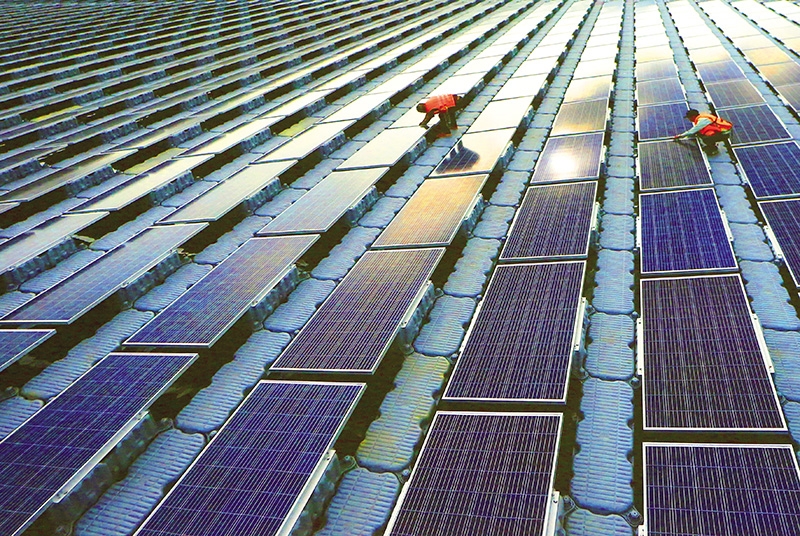Despite bankability concerns in power purchase agreements, investing in solar power is a new boom in Vietnam as developers, original equipment manufacturers, and contractors rush into the market thanks to the current feed-in tariff. However, it remains to be seen if an upcoming policy is attractive enough to both keep them and meet surging demand. VIR’s Nguyen Thu reports.

Last week, more than 300 companies and 70 professional speakers gathered at the Solar
Last week, more than 300 companies and 70 professional speakers gathered at the Solar Power Expo Vietnam 2019 (SPEV) in Hanoi to seek opportunities for the next round of the feed-in tariff (FiT) mechanism that will become effective for projects with commercial operation date (COD) from the end of June this year.
The event showcased that the Vietnamese solar sector is hotter than ever with no sign of slowing down, as hundreds of registered projects with capital of billions of US dollars were established in just a short time to enjoy the outcomes of the prime minister’s Decision No.11/2017/QD-TTg issued in April 2017 on mechanisms for encouragement of the solar power development in Vietnam. Under Decree 11, the FiT is 9.35 US cents per kilowatt-hour (kWh) for solar power in Vietnam, which sparked an investment rush before the cut-off date. In the south-central provinces of Ninh Thuan and Binh Thuan, installed capacity of approved solar projects has reached nearly two gigawatts and 4GW, respectively, according to the Ministry of Industry and Trade (MoIT).
Meanwhile, Neoventure, a Chinese-based independent investment advisory agency and also organiser of the SPEV noted that Vietnam, the hottest destination for solar power investment in the Asia Pacific, has had 3GW of solar projects installed after the first round of FiT mechanism was put into effect, with more than 1GW of solar power installation for yearly growth.
To commission its electricity target for 2030, Vietnam requires around $10 billion a year. As a result, many companies such as B.Grimm Group, Sunseap Group, VinaCapital, Macquarie Group, Trina Solar Ltd., and more are looking to make a mark in the country.
To further enhance renewable energy and sustainable development in Vietnam, the MoIT released an updated draft of the decision of the prime minister on encouraging solar venture development.
Under the latest draft for the next round of the FiT mechanism to be applied for projects reaching COD within the period from July 1, 2019 to December 31, 2021 and applied for 20 years from the COD date, there will be only one region for the rate instead of four regions now.
The new proposed FiT for the whole of Vietnam sits at VND1,620 (7.09 US cents) per kWh for ground-mounted solar energy project and VND1,758 (7.69 US cents) per kWh for floating solar energy projects.
The 9.35 US cent rate will be maintained for rooftop solar power projects, and the FiT for floating solar and ground-mounted solar power projects will be reduced in comparison with the first round FiT of Decision 11.
The MoIT explained that the FiT for solar power is applied in order to meet with development of transmission lines, local infrastructure, and the grid. A decision is expected on the next FiT rate imminently.
Jorrmsump Lachaya, chairman of Thailand’s Super Energy Corporation Plc. told VIR at the SPEV that the Vietnamese power market, especially for solar energy, was attractive due to its high power demand and the government’s commitments to diversification of power generation, with increased emphasis on renewable energy as the solution.
“The offer of the current FiT for solar power in Vietnam is attractive, but it should not be compared with other countries as demand and infrastructure in each are different,” said Lachaya.
Kobe Qin, sales director of Asia-Pacific at GCL System Integration Technology Co., Ltd. said, “The Vietnamese government has quite a clear strategy to develop renewable energy. The shortage of power will require Vietnam to develop more in renewable energy.”
Vietnam has high ambitions for renewable energy, as shown in the Revised National Power Development Master Plan VII. The plan stipulates that 21 per cent of the total energy supply should come from renewable sources by 2030.
As plans for a nuclear power plant have already been postponed by the National Assembly, the country is pushing for more alternatives to satisfy its energy hunger. Foreign investors are especially welcome, as there is no foreign ownership limit and many attractive tax incentives are offered.
Gavin Smith, director of Dragon Capital’s Clean Development said that solar energy installed capacity rapidly has passed 4,500 megawatts in 2019, but the nameplate capacity has not turned into a high volume of power being delivered. “The limited grid capacity in Ninh Thuan and Binh Thuan provinces has cut solar production in these important solar plants by up to 57 per cent. Renewable energy remains a minor part of the picture despite Vietnam’s excellent resources in wind and sun,” Smith said.
According to him, actions need to be taken to open up the power market to free competition and to allow the free flow of capital.
Meanwhile, Bence Szeged, vice president of Asia Investment Team at SUSI Partners which is a Swiss infrastructure fund manager, said Vietnam is high in potential, but he remained concerned that a vague FiT “reduces the number of gold diggers” postulating for getting their hands on the various projects across Vietnam.
The government is targeting to triple installed capacity by 2030 to meet the demand of the fast-growing economy. The success in attracting investment in the solar sector has shown how quickly change can come, but it also highlights the need for an up-to-date and synchronous power plan that takes into account distribution as well as generation.
Source: https://www.vir.com.vn







